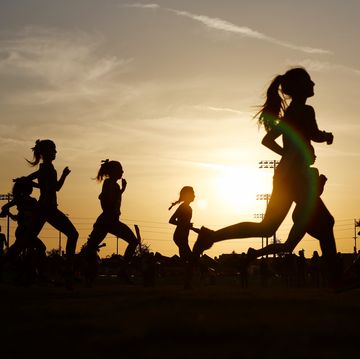In 2000, Kelley Hyatt went out to cheer for a friend running the Tuft's 10K, a now 37-year-old women-only race held in Boston. "As soon as I saw the race, I said, ‘Next year I'm doing that,’" said Hyatt, 45. It was her first 10K. Next Monday, she'll run the race for the seventh time.
"There's a different vibe," she said about Tufts compared to co-ed races she's run. "It feels like a celebration of women's running."
Women-only races started as a way to show the world that women could run long distances, and to give women a place to prove to themselves that they could run.
By all accounts, those goals have been met. Since 2010, U.S. road races have had more women finishers than men. In 2013, 10.8 million race finishers – 57 percent of the total – were women. Last year, 61 percent of half marathon finishers and 43 percent of marathon finishers in U.S. races were women, according to Running USA.
So why still have women's races? The answer, observers say, is partly legacy and partly continuing to provide what feels like a safe space in which to run. As Hyatt said, the vibe is just different.
When Women's Running Was New
The Advertisement - Continue Reading Belows put on the first women'-only road race in 1972. What’s now known as the New York Mini 10K was originally called the Crazylegs Mini Marathon. (The sponsor was SC Johnson, promoting a new shaving gel called Crazylegs. The “mini” originally referred to miniskirts.)
&who, in 1967, was the first women to officially enter the Mary Wittenberg, president and CEO of NYRR. The race had only 78 runners. To draw attention to the event, organizers had Playboy Bunnies kick off the race.
Kathrine Switzer, who, in 1967, was the first women to officially enter the Boston Marathon, both ran in and helped organize the Crazylegs race. She also created the Avon International Running Circuit in 1978, which put on races in 27 countries.
The Avon series had three purposes. The first was to let the world know that women runners existed. "We wanted to prove to the public that women could run, and we wanted to bust some pretty old myths," said Switzer. One such myth was that women were too weak to run distances or they'd sterilize themselves if they did.
Second, organizers wanted to create opportunities for women so that they could try running and prove to themselves they could do it. The third reason was political: Switzer was part of the team that lobbied to get the women's marathon into the Olympics, which happened in 1984. "We knew if someone were not recognized at the highest level of the sport, nobody would take them seriously," she said.
The Modern Women-Only Race
Last year, the four largest U.S. women-only races each had more than 10,000 finishers. The Nike Women's Half Marathon San Francisco, the largest women's race of 2013, had 25,058. Nike's DC Half Marathon, which in 2015 will move to another location to be announced, came in third with 13,911. Disney held the second and fourth spots with the Disney Princess Half Marathon (21,217 finishers) and Tinker Bell Half Marathon (10,560 finishers).
"Many of these women are experience a sense of empowerment that they never had before," said Switzer of women running women-only races today. Switzer continues to spread that message internationally, including as part of the 261 Women's Marathon and 10K, which is run in Spain. (261 was her Boston Marathon bib number in 1967.) "They're in control of their bodies and therefore their destinies,” Switzer said. “For the first time in their life they really feel that wonderful sense of accomplishment and self-esteem."
In addition to the New York Mini 10K, the Advertisement - Continue Reading Belows added the More/Fitness Magazine Women's Half Marathon in 2003. In 2013, it was the fifth largest women's race of 2013, with 7,572 finishers.
Wittenberg said that women-only races are still crucial for new runners, who may feel more comfortable running with other women. (The NYRR races are strictly women-only, while other women's races mentioned in this article allow men to run.)
"We no longer need as many as we might have back in the day in terms of making sure women have plenty of opportunities to run, but from a point of celebration, of the importance of empowering women to running and well beyond, it remains important." Wittenberg said. "It's just really fun to run with other women every now and then."
Robert and Gaby Pozo organize the five-year-old Divas series, which includes 5Ks and half marathons in 10 cities, and had 43,000 finishers last year.
"Its fun. It's girly. It's girl power," said Robert Pozo. For their 2013 North Myrtle Beach races, which Pozo said is typical of the race series, 68 percent of finishers were 30 to 49 years old, and 37 percent of finishers had a household income of over $100,000.
Many of their runners are established in their careers, can afford to travel and pay for races, and use races as a reason for an all-women vacation, said Pozo. "These are women that don't only do women's races, but every so often they like to get away with their physically fit gal pals and do one of these races."
Women-Only Backlash
Divas and other women's races have been criticized for reinforcing gender stereotypes. Finishers in Nike's half marathons are given Tiffany's bracelets by men in tuxedos. Divas races include a feather boa and tiara stops, and finishers are met by shirtless firefighters with roses.
"The assumption is that women will want this sort of male gaze and male attention, particularly with these kinds of awards at the end," said Kristin Jacobson, associate professor of women's gender and sexuality studies at Stockton College. Races that focus on things like pink and princesses and jewelry also push conventional ideas of what women should be, according to Stockton. "It's such a narrow definition of what constitutes femininity," she said.
She points to organizations like Black Girls Run and Girls on the Run as examples of groups that encourage girls and women to start running in a safe space without telling them what being feminine means.
The Divas series also came under fire for awards it gave to the 15-to-19 age-group winners in its Miami races. Prizes included gift certificates to a spa with services like teeth whitening and laser hair removal. Pozo said the race offered those prizes because they were donated by a Miami day spa. There are no longer Divas races in Miami, not because of controversy over the prizes, Pozo said, but because that specific race wasn't financially successful.
Do You Burn More Calories on Your Period, Women's Running magazine postponed four half marathons that had been part of a five-event series.
"We started talking to women and really looking at ourselves and finding out what we wanted from races," said Jessie Sebor, vice president of Women's Running. "We really wanted something different, something that wasn't being done in the market currently and to be able to make that really new, special exciting experience," she said.
Those new races will be announced in early 2015 as part of the ever-evolving women’s running scene.













